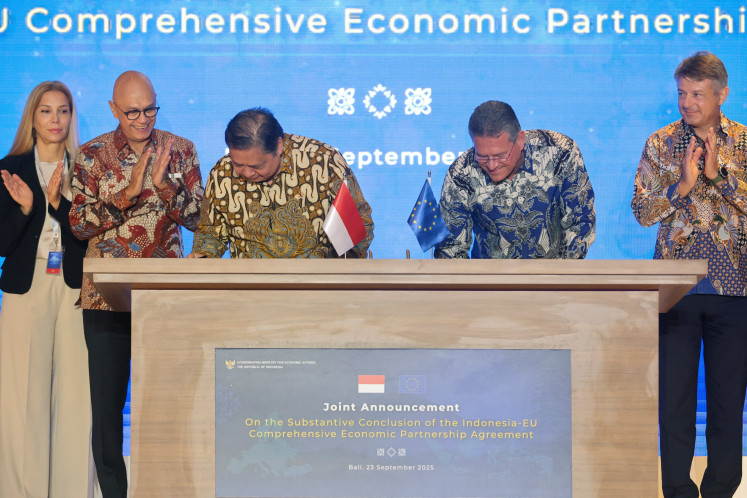Popular Reads
Top Results
Can't find what you're looking for?
View all search resultsPopular Reads
Top Results
Can't find what you're looking for?
View all search resultsASEAN urged to build a sense of community for integration
ASEAN nations need to build their sense of community and refrain from competing among themselves if they wish for economic integration efforts to succeed, a recent panel discussion has concluded
Change text size
Gift Premium Articles
to Anyone
A
SEAN nations need to build their sense of community and refrain from competing among themselves if they wish for economic integration efforts to succeed, a recent panel discussion has concluded.
Two years after the establishment of the ASEAN Economic Community (AEC), members of the Southeast Asian bloc still face internal challenges to ongoing regional integration.
Expert Prapat Thepchatree of Thailand’s Thammasat University argued that progress on crucial issues like connectivity continues to be hampered by a lack of cohesiveness among member states, in spite of the good reputation the bloc enjoys internationally.
“Unless a common identity is created, ASEAN member states will always see each other as competitors, not as partners,” he told a panel at the ASEAN Golden Jubilee Symposium in Jakarta, on Thursday.
For example, he said, the Master Plan on ASEAN Connectivity (MPAC) 2025, a regional road map that envisions a comprehensively connected and integrated ASEAN, remains a work-in-progress due to disparities between member states.
Ranking among the top 10 economies in the world with a gross domestic product (GDP) of US$3 trillion, the 10-nation ASEAN has been touted as one of the region’s drivers of economic growth, with its annual average collective GDP growth projected at 5.2 percent between 2016 and 2020.
From an industry standpoint, the regional integration process provides a unique opportunity for ASEAN to interlink in a way that makes the most of its member states’ potentials, another panelist and president of the Singapore Manufacturing Federation, Douglas Foo, asserted.
In his view, Singapore and other Southeast Asian nations individually stand to benefit economically from ASEAN as a collective.
Citing a recent Committee on the Future Economy report that predicts the island nation’s manufacturing sector will contribute 20 percent of GDP, the industrialist touted the need for Singapore to leverage its membership of ASEAN to achieve that goal.
“We are fully aware that our market is limited. [Hence] the need to expand overseas. ASEAN has always been our most important market,” Foo said.
One possible suggestion he tabled was a collaborative business model that would incorporate all ASEAN countries across the manufacturing value chain, with Singapore leveraging its strong intellectual property rights, Vietnam its packaging industry and Laos its human capital.
“By leveraging each other’s strengths, ASEAN could offer an attractive proposition as a total solution hub for manufacturing the next generation of products for the global market,” Foo said.
“We must avoid viewing our expansion and integration in terms of competition with one another, but see it [as] a collaboration.”
An absence of “common ownership” in ASEAN may, according to analysts, also stem from a lack of awareness about the benefits people at the grassroots level derive from the bloc.
According to a 2014 poll conducted by the Institute of Southeast Asian Studies (ISEAS), just 55.8 percent of citizens across the ten ASEAN countries were familiar with the regional organization.









